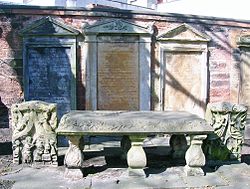| James Neill | |
|---|---|
| File:File:General Neill.jpg | |
| Born | May 26, 1810 |
| Died | September 25, 1857 (aged 47) |
| Place of birth | Swindridgemuir, Scotland |
| Place of death | Lucknow, British India |
| Allegiance |
|
| Service/branch | Madras Army |
| Years of service | 1827-1857 |
| Rank | Brigadier-General |
| Battles/wars |
Second Burmese War Crimean War Indian Rebellion of 1857 |
James George Smith Neill (26 May 1810 – 25 September 1857) was a British soldier. Neill was born at Swindridgemuir, near Dalry, Scotland and educated at the University of Glasgow. Entering the service of the British East India Company in 1827, he received his lieutenant's commission a year later. From 1828 to 1852 he was mainly employed in duty with his regiment, the 1st Madras Europeans (of which he wrote a Historical Record), but gained some experience on the general and the personal staffs as D.A.A.G. and as aide-de-camp. In 1850 he received his majority, and two years later set out for the Second Burmese War with the regiment. He served throughout the war with distinction, became second-in-command to Cheape, and took part in the minor operations which followed, receiving the brevet of lieutenant-colonel.

The burial plot of the Smith Neills of Swindrigemuir and Barnweill at Ayr Auld Kirk.
In June 1854 he was appointed second-in-command to Sir Robert Vivian to organize the Turkish contingent for the Crimean War. Early in 1857 he returned to India. Six weeks after his arrival came the news that all northern India was aflame with revolt (see the Indian rebellion of 1857). Neill acted promptly; he left Madras with his regiment at a moment's notice, and proceeded to Benares. As soon as he arrived on 3 June, he preemptively disbanded the local native regiment. A regiment of Sikhs stationed at Varanasi, normally considered 'loyal', revolted. They fled after Neill's commanders shot at them, but returned to duty later.[1]
On 9 June, General Neill set out for Allahabad, where a handful of Europeans still held out in the fort against the rebels. General Neill ordered hanging of those suspected of being the mutineers.[2] His Sikh forces stationed at Jaunpur revolted upon seeing these massacres.[1] From 6 to 15 June his men forced their way under conditions of heat and of opposition. Neill received his reward in an army colonel and appointment and aide-de-camp to the queen.
Allahabad was soon made the concentration of Henry Havelock's column. Neill then turned to the besieged Kanpur. Following the Bibighar massacre of British women and children at Kanpur, General Neill indulged in indiscriminate killings of Indians. He inflicted the death penalty on all his prisoners. He compelled the high-caste Brahmins to wash up the blood of the Bibighar victims from the floor, an act that degraded them with the loss of caste. The prisoners were then hanged.[3]
Meanwhile, Havelock, in spite of a succession of victories had been compelled to fall back for lack of men; and Neil criticized his superior's action with a total want of restraint. A second expedition had the same fate, and Neill himself was now attacked, though by his own exertions and Havelock's victory at Bithor (16 August) the tension on the communications was ended. Havelock's men returned to Cawnpore, and cholera broke out there, whereupon Neill again committed himself to criticisms, this time addressed to the commander-in-chief and to Outram, who was on the way with reinforcements. In spite of his very grave acts of insubordination, Havelock gave his rival a brigade command in the final advance. The famous march from Cawnpore to Lucknow began on 18 September; on the 21st there was a sharp fight, on the 22nd incessant rain, on the 23rd intense heat. On the 23rd the fighting opened with the assault on the Alum Bagh, Neill at the head of the leading brigade recklessly exposing himself. Next day he was again heavily engaged, and on the 25th he led the great attack on Lucknow itself. The fury of his assault carried everything before it, and his men were entering the city when their commander was suddenly killed in action at Lucknow - 25 September 1857. Shot in the head at Khas Bazaar. The rank and precedence of the wife of a K.C.B. was given to his widow, and memorials have been erected in Lucknow and at Ayr. Memorial at the Residency, Lucknow reads - "Sacred to the memory of Brigadier General J.G.S. Neill A.D.C. to the Queen. Col J.L. Stephenson c.o. Major S.G.C. Renaud Lieut. W.G. Groom. Lieut N.H. Arnold. Lieut A.A. Richardson. Lieut J.A. Chisholm Liuet F. Dobbs 352 non-commissioned officers, drummers and rank and file of the First Madras Fusiliers who fell during the supression of the rebellion in Bengal 1857-58." An island in the Andamans was named after him, as a mark of honour and now Neill Island (or Neil Island), with its pristine beaches, is a popular tourist destination in India.
See also[]
- Neil statue satyagraha
References[]
- ↑ 1.0 1.1 George Bruce Malleson (1891). The Indian Mutiny of 1857. Seely and Company, Limited. pp. 181–184. http://books.google.com/books?id=pIrUAAAAMAAJ&pg=PA181. Retrieved 13 August 2013.
- ↑ Pramod K. Nayar (2007). The Penguin 1857 Reader. Penguin Books India. pp. 13. ISBN 978-0-14-310199-4. http://books.google.com/books?id=Y9rXdRwHd5UC&pg=PA13. Retrieved 13 August 2013.
- ↑ Illustrated London News, 26 September 1857. See C. Hibbert, The Great Mutiny: India 1857(London 1978) for further discussion,
- J. W. Kaye, Lives of Indian Officers (1889)
- J. C. Marshman, Life of Havelock (1867).
This article incorporates text from a publication now in the public domain: Chisholm, Hugh, ed. Encyclopædia Britannica Cambridge University Press
The original article can be found at James George Smith Neill and the edit history here.